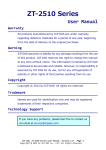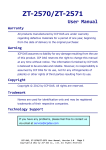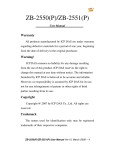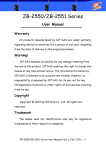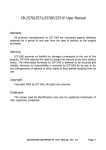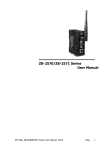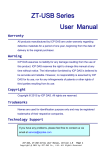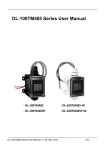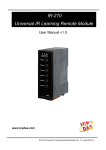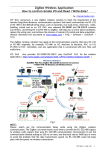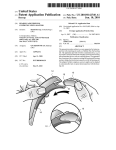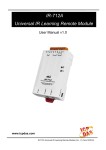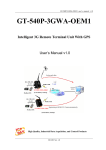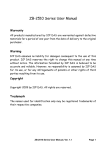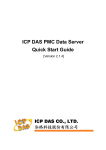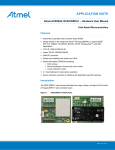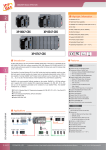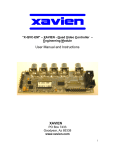Download ZT-255x 系列
Transcript
ZT-2550/ZT-2551 User Manual Warranty All products manufactured by ICP DAS are under warranty regarding defective materials for a period of one year, beginning from the date of delivery to the original purchaser. Warning ICP DAS assumes no liability for any damage resulting from the use of this product. ICP DAS reserves the right to change this manual at any time without notice. The information furnished by ICP DAS is believed to be accurate and reliable. However, no responsibility is assumed by ICP DAS for its use, nor for any infringements of patents or other rights of third parties resulting from its use. Copyright Copyright © 2013 by ICP DAS. All rights are reserved. Trademarks Names are used for identification purpose only and may be registered trademarks of their respective companies. Technology Support If you have any problems, please feel free to contact us via email at [email protected] ICP DAS, ZT‐2550/ZT‐2551 User Manual, Version 1.3 Page 1 Copyright @ 2013 by ICP DAS Co., Ltd. All Rights Reserved. Table of Contents 1 Introduction to ZigBee ............................... 4 2 Introduction to the ZT‐255x Module ................... 5 3 Hardware Information ................................. 6 3.1 Specifications ........................................ 6 3.2 ZT‐255x Front View .................................... 7 3.3 Dimensions (Units: mm) ................................ 9 3.4 Block Diagram ........................................ 10 3.5 Wire Connections ..................................... 10 4 Setting up the ZT‐255x module ....................... 11 4.1 Introduction of configurations ....................... 11 4.2 Connecting the Power and Host PC ..................... 18 4.3 Configuring ZigBee Setting ........................... 20 4.4 Test Communications .................................. 23 5 Applications ........................................ 24 6 Troubleshooting ..................................... 25 6.1 Technical Support .................................... 25 7 Appendixes .......................................... 26 7.1 LED Indicator Status ................................. 26 7.2 DCON/MODBUS Module Communication ..................... 27 7.3 Non‐addressable Device Communication ................. 29 ICP DAS, ZT‐2550/ZT‐2551 User Manual, Version 1.3 Page 2 Copyright @ 2013 by ICP DAS Co., Ltd. All Rights Reserved. What’s in the shipping package? The shipping package includes the following items: ZT‐255x Device ANT‐124‐05 CA‐0915 (ZT‐2550) / CA‐0910N (ZT‐2551) Release Note CD If any of these items are missing or damaged, please contact your local distributor for more information. Save the shipping materials and cartons in case you want to ship the module in the future. More Information Documentation: CD: \Napdos\ZigBee\ZT_Series\Document http://ftp.icpdas.com/pub/cd/usbcd/napdos/zigbee/zt_series/document Software: CD: \Napdos\ZigBee\ZT_Series\Utility http://ftp.icpdas.com/pub/cd/usbcd/napdos/zigbee/zt_series/utility ICP DAS, ZT‐2550/ZT‐2551 User Manual, Version 1.3 Page 3 Copyright @ 2013 by ICP DAS Co., Ltd. All Rights Reserved. 1 Introduction to ZigBee ZigBee is a specification for a suite of high-level communication protocols using small, low-power digital radios based on the IEEE 802.15.4 standard for personal area networks. ZigBee devices are often used in mesh network form to transmit data over longer distances, passing data through intermediate devices to reach more distant ones. This allows ZigBee networks to be formed ad-hoc, with no centralized control or high-power transmitter/receiver able to reach all of the devices. Any ZigBee device can be tasked with running the network. ZigBee is targeted at applications that require a low data rate, long battery life, and secure networking. ZigBee has a defined rate of 250 kbit/s, best suited for periodic or intermittent data or a single signal transmission from a sensor or input device. Applications include wireless light switches, electrical meters with in-home-displays, traffic management systems, and other consumer and industrial equipment that requires short-range wireless transfer of data at relatively low rates. The technology defined by the ZigBee specification is intended to be simpler and less expensive than other WPANs. ICP DAS, ZT‐2550/ZT‐2551 User Manual, Version 1.3 Page 4 Copyright @ 2013 by ICP DAS Co., Ltd. All Rights Reserved. 2 Introduction to the ZT‐255x Module The Basis of ZT-255x Series Product The ZT-2550 and ZT-2551 series modules are small-sized wireless ZigBee converters based on the IEEE802.15.4 standard that allow RS-232, RS-485 interface to be converted to a personal area ZigBee network. The typical transmission of ICP DAS ZT series ZigBee products is 700 meters (LOS, line of sight), with a transmission frequency range of between 2.405 GHz and 2.48 GHz, separated into 5 MHz sectors, providing 16 channels and 16384 PAN IDs. ZT-2000 series is not only a long distance wireless converter but also can act a ZigBee router to extend the transmission range and improve the quality of wireless signal. ZT-2000 series products are specification for a suite of high level communication protocols using small, low-power digital radios module, which are fitted the ZigBee 2007 (ZigBee Pro) of ZigBee Alliance. In the ZigBee network, it is only allowed one ZigBee Host and called “ZigBee Coordinator”, ZT-2550 series products, are used to initialize and manager the routing. In addition, One ZigBee network are able to manager 255 ZigBee router and responsible for receiving or bypassing data from parent or child node. The Benefits of ZT-255x Series Product A Windows compatible GUI configuration utility is available. The utility allows users to set different configurations based on the type of application, together with several of required ZigBee variables such as Pan ID. The friendly user interface is also helping user be familiar with ZT-2000 series. For more information, please refer to the relevant documents for these devices, which can be found at following link: http://ftp.icpdas.com/pub/cd/usbcd/napdos/zigbee/zt_series/document ICP DAS, ZT‐2550/ZT‐2551 User Manual, Version 1.3 Page 5 Copyright @ 2013 by ICP DAS Co., Ltd. All Rights Reserved. 3 Hardware Information 3.1 Specifications Part Number ZT-2550 (Coordinator) ZT-2551 (Router) Hardware MCU Module 8-bit microprocessor Temporary Buffer Size 256 Bytes LED Green ZigBee Net Yellow ZigBee RxD Red ZigBee Power Communication Interface (COM0) RS-232 COM0 RS-232 (TxD, RxD and GND); D-Sub 9 Female, Non-isolated D-Sub 9 Male, Non-isolated RS-485 RS-485 (DATA+, DATA-; internal ASIC self-tuner); Non-isolated Data Format N81, N82, O71, O81, E71, E81, S71, S81, M71, M81 Power Protection Power Reverse Polarity Protection EMS Protection ESD, Surge, EFT Required Supply Voltage +10 V DC ~ +30 V DC Power Consumption 1 W(Max.) Mechanism Casing Plastic Flammability UL 94V-0 materials Dimensions 33 ㎜ x 78 ㎜ x 107 ㎜ (W x L x H) Installation DIN-Rail ICP DAS, ZT‐2550/ZT‐2551 User Manual, Version 1.3 Page 6 Copyright @ 2013 by ICP DAS Co., Ltd. All Rights Reserved. Environment Operating Temperature -25°C ~ +75°C Storage Temperature -40°C ~ +80°C Relative Humidity 5 ~ 95% RH (non-condensing) Wireless RF Channels 16 RF Transmit Power 11 dBm Antenna (2.4GHz) 5 dBi Omni-directional antenna Transmit Range (LOS) 700 m (Typical) Max. Slaves Supported 255 EMI Certification CE/FCC, FCC ID WARNING! Installation Requirements Before to Use In compliance with the EN 60950-1 declaration, ZT-2000 series modules are NOT portable devices and should be DIN-Rail mounted. The ZT-2000 series is NOT designed for the general public. Please check the ZT-2000 series is set ready and well mounted before operating, beware of the hot part or surface when maintaining or reinstalling. ICP DAS, ZT‐2550/ZT‐2551 User Manual, Version 1.3 Page 7 Copyright @ 2013 by ICP DAS Co., Ltd. All Rights Reserved. 3.2 ZT‐255x Front View System LED Indicator 2.4 GHz RP-SMA Antenna 1 5 UL 94V-0 Materials 4 +10~+30 VDC Power Input Operating Mode DIP Switch RS-232 3 2 and RS-485 1. LED Indicator Status LED Indicator LED Color Explain ZigBee Net Green The status of ZigBee network. ZigBee RxD Yellow The status of ZigBee communication ZigBee PWR Red The status of module board ※ For more details, please see the section 6 troubleshooting. 2. Operating Mode DIP Switch ZBSET: Configuration mode is able to use ZT Configuration Utility to configure via the RS-232 or RS-485 interface. ZBRUN: Transmit mode is used to transmit data to the remote device. 3. RS-485 and +10 V DC ~+30 V DC Power Input The RS-485 and RS-232 are communicable via the same UART. The ZigBee PWR indicator will be steady light if correct power input. 4. RS-232 The RS-485 and RS-232 are communicable via the same UART. 5. 2.4 GHz RP-SMA Omni-directional Antenna If there is any requirement for extension cable, it must be a connector with the type RPSMA and resistance 50 Ohm. Ex. 3S001-1, 3S003-1...etc ICP DAS, ZT‐2550/ZT‐2551 User Manual, Version 1.3 Page 8 Copyright @ 2013 by ICP DAS Co., Ltd. All Rights Reserved. 3.3 Dimensions (Units: mm) Left Side View Front View Top View Rear View Right Side View Bottom View ICP DAS, ZT‐2550/ZT‐2551 User Manual, Version 1.3 Page 9 Copyright @ 2013 by ICP DAS Co., Ltd. All Rights Reserved. 3.4 Block Diagram LED Display RS‐232 Interface ZigBee Module MCU RS‐485 Interface Setting Switch EEPROM Power Circuit +10 ~ 30 VDC 3.5 Wire Connections 1. RS-232 GND ZT‐2570 RxD TxD CA‐0915 ZT‐2571 TxD RxD GND CA‐0910N 2. RS-485 DD+ D+D - ICP DAS, ZT‐2550/ZT‐2551 User Manual, Version 1.3 Page 10 Copyright @ 2013 by ICP DAS Co., Ltd. All Rights Reserved. 4 Setting up the ZT‐255x module 4.1 Introduction of configurations 1. “Pan ID” is the group identity of a ZigBee network, and must be the same if they are in the same ZigBee network. (Valid values range from 0x0000 to 0x3FFF) 2. “Node ID” is the identity of the ZigBee module. The identity number must be unique if it is in the same ZigBee network as other ZigBee module. (Valid values range from 0x0001 to 0xFFF7 for a ZigBee Router, but is fixed to 0x0000 for a ZigBee Coordinator) 3. “RF Channel” indicates the radio frequency channel, and must be set to the same channel if the module is in the same ZigBee network as other ZigBee modules. Channel 0x00 0x01 …… 0x0F Use application tools or analyzers to detect the wireless signal, chose a RF Channel which has not been occupied. E.g. Wifi Analyzer As below the screenshot shown, there were several WLANs over the channel 1, 6 and 11. Referring to the channel table of WiFi and ZigBee, the channels of ZigBee 4, 9, E and F are not overlap with WLAN. So, the RF Channel 4, 9, E and F of ZigBee are recommended in this case. ICP DAS, ZT‐2550/ZT‐2551 User Manual, Version 1.3 Page 11 Copyright @ 2013 by ICP DAS Co., Ltd. All Rights Reserved. RFU-2400/ZigBee WiFi CH 0 (2405) CH1 (2410) CH 2 (2415) CH 1 (2412) CH 2 (2417) CH3 (2420) CH 3 (2422) CH 4 (2425) CH 4 (2427) CH 5 (2430) CH 5 (2432) CH6 (2435) CH 6 (2437) CH 7 (2440) CH 8 (2445) CH 9 (2450) CH A (2455) CH B (2460) CH C (2465) CH D (2470) CH E (2475) CH 7 (2442) CH 8 (2447) CH 9 (2452) CH 10 (2457) CH 11 (2462) CH 12 (2467) CH 13 (2472) CH F (2480) CH 14 (2484) ‧RF Channel Table to ZigBee(802.15.4) and WLAN(IEEE 802.11b/IEEE 802.11g) ICP DAS, ZT‐2550/ZT‐2551 User Manual, Version 1.3 Page 12 Copyright @ 2013 by ICP DAS Co., Ltd. All Rights Reserved. 4. “RF Power” denotes the wireless transmit power value. Code Note 0x0F Typical Maximum 0x08 Fit the CE/FCC certification 0x00 Typical Minimum ※ The parameter adjustment purely personal behavior, ICP DAS can not guarantee to pass CE/FCC certification if adjusting this parameter, nor assume any liability because of the adjustment parameters derived from the RF Power. 5. “Baud rate & Data Format” values are based on the configuration of the serial port. Item Specification Parity None, Odd, Even, Space and Mark Data Bit 7, 8 Stop Bit 1, 2 Baud rate 1200 to 115200 bps ICP DAS, ZT‐2550/ZT‐2551 User Manual, Version 1.3 Page 13 Copyright @ 2013 by ICP DAS Co., Ltd. All Rights Reserved. 6. Communication Speed (The Interval Time of Sending Broadcast Frame): The data payload of ZT-2000 series modules is 79 bytes. Once the data is more than 79 bytes, it will be divided into several packets. This parameter is used to decide the interval time of sending broadcast frame in order to prevent the network crashes. Please fill in the number of ZT-2000 slaves nearby the ZigBee Coordinator. Example: RS-232 200 Bytes RS-485 Ethernet 75ms 42 B 75ms 79 Bytes 79 Bytes RS-232 79 Bytes 79 Bytes 42 B RS-485 Ethernet (Keep relay data) ICP DAS, ZT‐2550/ZT‐2551 User Manual, Version 1.3 Page 14 Copyright @ 2013 by ICP DAS Co., Ltd. All Rights Reserved. 7. Application Mode can be changed and used for certain specific purpose. ZC ZS 00 00 ZS 00 01 ZC ZigBee Coordinator ZS ZigBee Slave 00 02 The above schematic diagram is showing what the difference of using different application modes. a. Transparent Mode is the default application mode, and always transmits data to the remote device via broadcasting. Unless there are specific purposes, the application mode can be retained as default. The mode always bypasses data to remote side via broadcasting. If there is no particular purpose, user only keeps this application mode. Module Frame Type Note ZT-2550 Broadcast Data will be sent to all ZigBee slaves ZT-2551 Unicast Data will only be sent to the coordinator [Eg1] When ZT-2550 ZigBee Host sends “DATA_01” via broadcasting frame, → Both of the ZigBee slave 0x0001 and 0x0002 will receive the DATA_01. ※Broadcasting type frame, data will be sent to every ZigBee slaves in the same ZigBee network [Eg2] When the ZigBee slave 0x0001 sends “DATA_02” via unicast frame, → Only ZT-2550 receives DATA_02. ※Unicast type frame, data will only be sent to the ZigBee host DATA_03 ZC_0000 DATA_02 Transparent DATA_01 DATA_02 ZS_0001 Transparent ZS_0002 Transparent DATA_03 ※ There is an “Advanced Settings” for some specific user, please refer the section 7.3 ”Non-addressable Device Communication” to user manual for more information. ICP DAS, ZT‐2550/ZT‐2551 User Manual, Version 1.3 Page 15 Copyright @ 2013 by ICP DAS Co., Ltd. All Rights Reserved. b. Addressable Mode is an advanced application mode and it is used to send data to specific ZigBee nodes. It is not only used to transmit data to specific ZigBee slaves from host but also transmit data between ZigBee slaves. A 5-byte ASCII code should be added as an index before the data. Module ZT-2550 ZT-2551 Frame Type Note Data will be sent to a specific ZigBee slave. Unicast Format: “:AAAA” + Data [Eg1] When ZT-2550 ZigBee Host sends “:0001DATA_01” via unicast frame, →Only the ZigBee Slave 0x0001 receives DATA_01. ※Unicast type frame, data will be only sent to the specific ZigBee node [Eg2] When ZigBee slave 0x0001 sends “:0002DATA_02” via unicast frame →Only the ZigBee Slave 0x0002 receives DATA_02. ※Unicast type frame, data will be only sent to the specific ZigBee node DATA_03 :0001DATA_01 DATA_04 ZC_0000 Addressable :0002DATA_02 ZS_0001 Addressable DATA_01 DATA_04 DATA_02 ZS_0002 Transparent DATA_03 ※ There is an “Advanced Settings” for some specific user, please refer the section 7.3 ”Non-addressable Device Communication” to user manual for more information. ICP DAS, ZT‐2550/ZT‐2551 User Manual, Version 1.3 Page 16 Copyright @ 2013 by ICP DAS Co., Ltd. All Rights Reserved. c. Gateway Mode is an advanced application mode and it is used to convert the Modbus protocol. But there is only RS-232 and RS-485 interface supported in the ZT-255x device, so the data is always regarded as Modbus RTU format transmission. Module Frame Type Broadcast (Default) ZT-2550 Note Data is sent to all of ZigBee slaves Data will be sent to a specific ZigBee slave. Unicast (Advanced) ZT-2551 Unicast The Address of DCON/Modbus command is regarded as destination ZigBee address Data only be sent to coordinator [Eg1] When ZT-2550/ZT-2570 receives data “MRTU_CMD_01” from serial port, →ZT-2551 will output the data “MRTU_CMD_01” to serial port directly. [Eg2] When ZT-2570 receives data “MTCP_CMD_02” from Ethernet, →ZT-2551 will convert protocol then output “MRTU_CMD_01” to serial port. [Eg3] When ZT-2551 transmits the acknowledgement “MRTU_ACK_03”, →ZT-2550/ZT-2570 will response the acknowledgement “MRTU_ACK_03” to serial port directly. →ZT-2570 will convert protocol then output “MTCP_CMD_01” to Ethernet. ※Unicast type frame, data will only be sent to the ZigBee host MODBUS RTU Serial MODBUS TCP Ethernet ZC_0000 ZS_0001 Ethernet MODBUS TCP Serial MODBUS RTU ※ There is an “Advanced Settings” to the Gateway Mode for some specific user, please refer the section 7.2 “DCON/Modbus Device Communication” for more information. ICP DAS, ZT‐2550/ZT‐2551 User Manual, Version 1.3 Page 17 Copyright @ 2013 by ICP DAS Co., Ltd. All Rights Reserved. 4.2 Connecting the Power and Host PC 1. Confirm that the DIP switch is set to the “ZBSET” position. ZBSET ZBRUN 2. Connect the DC.GND and DC.+Vs pins with 10 to 30V power supply. F.G. D‐ D+ GND +VS DC.GND DC.+Vs SAFTY INSTRUCTION NOTES Before connecting the power source to the power input pins, ensure that both the installation of the unit in the completed system, and the DC power source (SELV, Limited Power Source) that is intended to be connected to the power input pins (DC.+Vs / DC.GND) comply with the requirements of EN 60950-1. ICP DAS, ZT‐2550/ZT‐2551 User Manual, Version 1.3 Page 18 Copyright @ 2013 by ICP DAS Co., Ltd. All Rights Reserved. 3. Connect either the RS-232 or RS-485 interface to configure the ZT-255x. RS-232: ZT‐2550: ZT‐2551: CA‐0915 CA‐0910N Windows Based PC RS-485: F.G. D‐ D+ GND +VS ZT‐255x RS‐485 Converter Windows Based PC 4. Enable the power. It means that the ZT-255x start-up procedure has been completed. If the red LED has changed from blinking to a steady light. ICP DAS, ZT‐2550/ZT‐2551 User Manual, Version 1.3 Page 19 Copyright @ 2013 by ICP DAS Co., Ltd. All Rights Reserved. 4.3 Configuring ZigBee Setting 1. Launch the “ZT Configuration Utility” and click the [ZT Series] button. 2. Click the [Serial Port] icon and then select the COM Port number. 1 2 3. After selecting the COM Port number, a list of model numbers will be displayed. Select the name of the module that you want to configure. After clicking the button, the utility will begin checking the connection. 3 ICP DAS, ZT‐2550/ZT‐2551 User Manual, Version 1.3 Page 20 Copyright @ 2013 by ICP DAS Co., Ltd. All Rights Reserved. 4. Once a connection is established, select either the [Default] or the [Wizard] function from the settings mode page. 4 Wizard Default 5. Whether you select either the [Default] or the [Wizard] option for performing configuration, both are used to configure the Pan ID, Node ID, RF Channel, RF Power, Baud rate, Data Format, Application Mode and so the relevant parameters. 8. Pan ID/Node ID/RF Channel/RF Power For more details, please see section 4.1. ICP DAS, ZT‐2550/ZT‐2551 User Manual, Version 1.3 Page 21 Copyright @ 2013 by ICP DAS Co., Ltd. All Rights Reserved. 9. Baud Rate and Data Format 10. Application Mode For more details, please see section 4.1. 6. Once the module configuration has been completed, the message “The Configuration was successful” will be displayed. Return the DIP switch to the “ZBRUN” position and reboot the ZT-255x device. ZBSET ZBRUN ICP DAS, ZT‐2550/ZT‐2551 User Manual, Version 1.3 Page 22 Copyright @ 2013 by ICP DAS Co., Ltd. All Rights Reserved. 4.4 Test Communications Method (1) Connect both the ZT-2550 and ZT-2551 to the Host PC via the RS-232 port. You may need to use two serial port tools to simulate the data transmission. Serial Tool Serial Tool RS‐232/RS‐485 RS‐232/RS‐485 ZT‐2550 ZT‐2551 Method (2): Use the DCON Utility on the Host PC to search for ZT-2000 series I/O modules. If there any devices are found, it means that the configuration is correct. DCON Utility RS‐232/RS‐485 ZT‐2550 ZT‐2000 ICP DAS, ZT‐2550/ZT‐2551 User Manual, Version 1.3 Page 23 Copyright @ 2013 by ICP DAS Co., Ltd. All Rights Reserved. 5 Applications (1)The ZT-255x is suitable for using in which is wiring difficult and low data rate environment. Eg. The I/O nodes are across the road, building or gutter…. Factory 01 Factory 03 ZT‐2000 I/O RS‐485 Serial ZT‐2550 Power Meter & M‐7000 ZT‐2551 Road ZT‐2000 I/O ZT‐2000 I/O ZT‐2551 Factory 02 RS‐485 Gutter Power Meter & M‐7000 (2)ZT-255x is suitable to use in monitoring and controlling. Eg. Smart energy, Home automation... Light Control Thermostat Audio Control Window treatment Security ICP DAS, ZT‐2550/ZT‐2551 User Manual, Version 1.3 Page 24 Copyright @ 2013 by ICP DAS Co., Ltd. All Rights Reserved. 6 Troubleshooting 6.1 Technical Support If you have any difficulties using your ZT-255x series module, please send a description of the problem to [email protected] Include the following items in your email: A description to the communication protocol for more information. A copy of the configuration file for the ZT-255x module. This file can be obtained using the procedure outlined below and should be attached to your email. a. Set the DIP switch of the ZT-255x device to the [ZBSET] position then reboot the device. Launch the ZT Configuration Utility and select [Save Log] icon to save the configuration of the ZT-255x as a file. b. After clicking the [Save Log] icon, enter the “File Name” and the “File Path” in the Windows “Save” dialog box. Once the configuration has been successfully saved, the following message will be displayed. ICP DAS, ZT‐2550/ZT‐2551 User Manual, Version 1.3 Page 25 Copyright @ 2013 by ICP DAS Co., Ltd. All Rights Reserved. 7 Appendixes 7.1 LED Indicator Status LED Indicator Status Introduction ZigBee Coordinator (Host) Steady Lit ZigBee network is Establish Blink to Steady Lit Rejoin ZigBee Network or It has Occupied ZigBee Net ZigBee Router (Slave) (Green LED) Steady Lit The Signal is Strong Blinking (500 ms) The Signal is Available Blinking (1s) The Signal is Weak Blinking (2s) The Signal is Unstable or There is no Available ZigBee RxD (Yellow LED) The status of ZigBee communication Blinking Receiving ZigBee Data Steady Unlit No ZigBee Data Received The status of module board Steady Lit Power ON ZigBee PWR Blinking (200ms) Module Initialization Failure (Red LED) Blinking (500ms) Configuration Mode Blinking (1s) Watchdog Enabled Steady Unlit Power OFF ICP DAS, ZT‐2550/ZT‐2551 User Manual, Version 1.3 Page 26 Copyright @ 2013 by ICP DAS Co., Ltd. All Rights Reserved. 7.2 DCON/MODBUS Module Communication ZigBee is defined as a low-power and low data rate wireless transmission protocol. In order to prevent excessive transmission loading to the ZigBee network, there is an advanced setting to the Gateway Mode to set the wireless frame type, which is used to select either the Broadcast Frame or Unicast Frame to transmit data. Once the Unicast Frame is selected, the Address of DCON or Modbus instructions will be regarded as the destination address to the ZigBee. So, the DCON/Modbus devices should be connected to corresponding address of ZigBee module. DCON/MODBUS Instruction To 0x02 ZT‐2550/ZT‐2570 Node ID = 0x0001 Address = 01 Node ID = 0x0002 Address = 02 Node ID = 0x0003 Address = 03 Unicast ZT‐2550/ZT‐2570 Node ID = 0x0001 Address = 01 Node ID = 0x0002 Address = 02 Node ID = 0x0003 Address = 03 Broadcast ICP DAS, ZT‐2550/ZT‐2551 User Manual, Version 1.3 Page 27 Copyright @ 2013 by ICP DAS Co., Ltd. All Rights Reserved. For some applications, there are several DCON or Modbus devices should be connected to the same ZT-2551 modules. 01 RS‐485 ZigBee Coordinator Node ID = 0001 02 RS‐485 Node ID = 0002 RS‐485 …… 03 04 05 Node ID = 0003 Although the addresses of these additional DCON and Modbus devices are not corresponding to the relative ZigBee module, but there is an Address Mapping function supported for redirection to the correct destination address of ZigBee module. User only fills in the relationship of address mapping for redirection via the ZT-2000 Configuration Utility. DCON/MODBUS Instruction To 0x04 ZT‐2550/ZT‐2570 Node ID = 0x0001 Node ID = 0x0002 Node ID = 0x0003 Unicast ICP DAS, ZT‐2550/ZT‐2551 User Manual, Version 1.3 Page 28 Copyright @ 2013 by ICP DAS Co., Ltd. All Rights Reserved. 7.3 Non‐addressable Device Communication In some applications, there are some devices can not be addressable and they even take the initiative to reply data. Once these non-addressable devices send data to the user's controller via ZigBee, the user program can not identify which device sends this data. For example, there are several barcode readers and RS-232 device connected to the ZT-2551. Once these devices are triggered to reply data, the controller will not be able to identify which end device sends the data. AAAAA Barcode Reader Barcode Reader Barcode Reader DDDDD BBBBB CCCCC RS-232 Device EEEEE AAAAA BBBBB CCCCC DDDDD EEEEE ….. RS-232 Device ICP DAS, ZT‐2550/ZT‐2551 User Manual, Version 1.3 Page 29 Copyright @ 2013 by ICP DAS Co., Ltd. All Rights Reserved. In order to provide a solution for the similar application using non-address device, there is an advanced setting to the Transparent Mode and Addressable Mode to show the Node ID of the remote ZigBee device which is connected to the userʼs end-device. When the advanced function is enabled, the Node ID will be added in the “:AAAA” format in front of the original data and then be output once receiving remote data. AAAAA Node ID=0001 Node ID=0002 Node ID=0003 DDDDD BBBBB CCCCC :0001AAAAA :0002BBBBB :0003CCCCC :1234DDDDD :ABCDEEEEE ….. Node ID=1234 EEEEE Node ID=ABCD ICP DAS, ZT‐2550/ZT‐2551 User Manual, Version 1.3 Page 30 Copyright @ 2013 by ICP DAS Co., Ltd. All Rights Reserved.
































